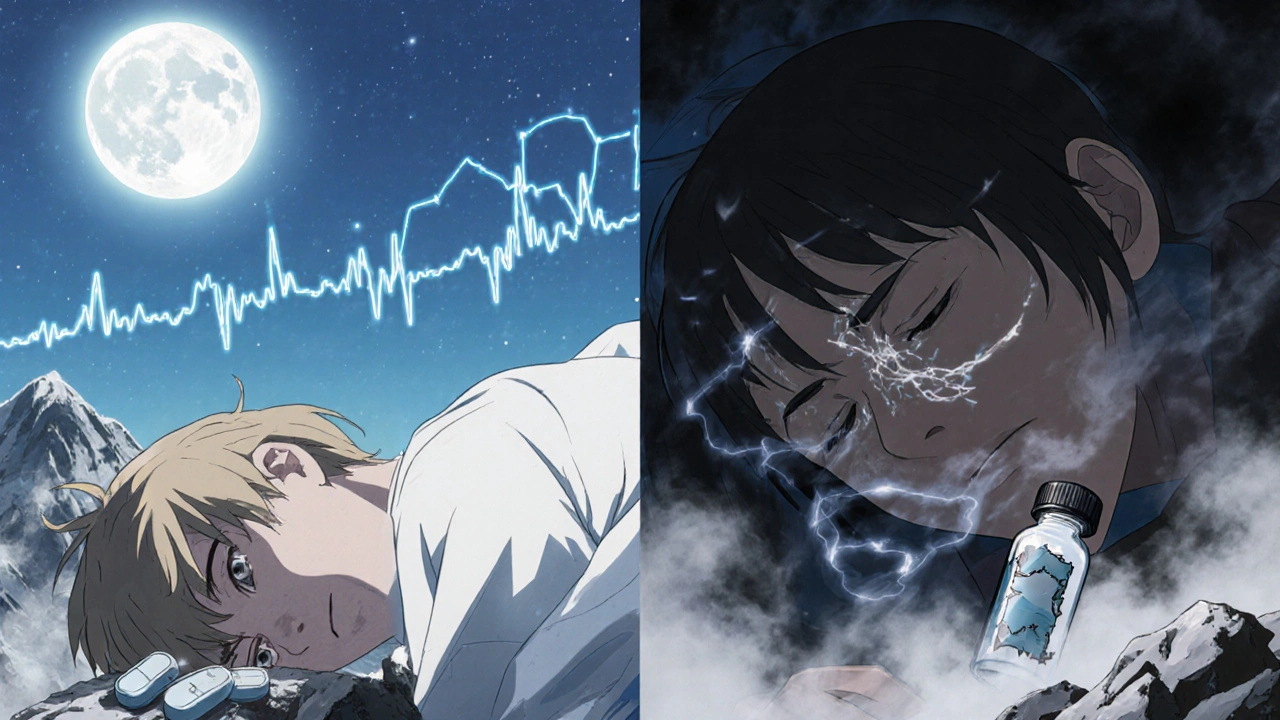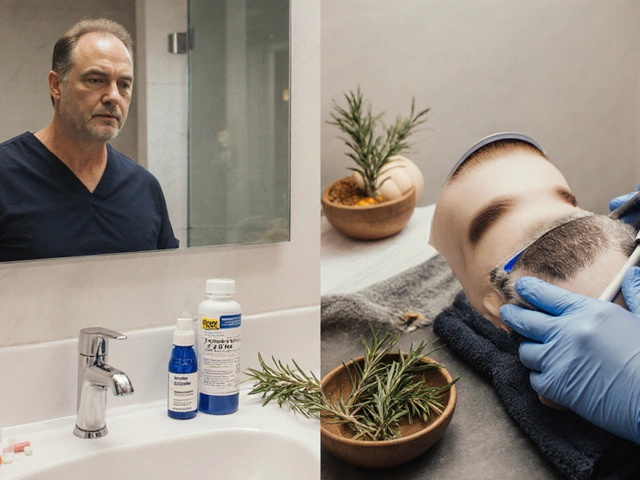Going high up in the mountains can be exhilarating-clear air, breathtaking views, and a sense of accomplishment. But if you’re planning to take a sedative to help you sleep or calm your nerves, you’re putting yourself at serious risk. At altitudes above 2,500 meters (8,200 feet), your body is already struggling to get enough oxygen. Adding a sedative to the mix doesn’t just make sleep harder-it can push your breathing to the edge, even stop it briefly while you sleep. This isn’t speculation. It’s well-documented medical fact, backed by decades of research and real-world cases from climbers, trekkers, and travelers who ignored the warnings.
Why Altitude Changes Your Breathing
At sea level, the air contains about 21% oxygen. That doesn’t change as you climb. But the air gets thinner. For every 1,000 meters you go up, the pressure drops by about 6.5%. That means fewer oxygen molecules in every breath you take. Your body knows this. Within minutes, it tries to compensate by making you breathe faster and deeper. This is called the hypoxic ventilatory response-and it’s your lifeline.
But here’s the catch: as you breathe more, you blow off too much carbon dioxide. That makes your blood more alkaline, which then tricks your brain into slowing your breathing down. This creates a cycle: breathe fast → CO2 drops → breathing slows → oxygen drops → breathe fast again. This pattern, called periodic breathing, affects up to 75% of people sleeping above 2,700 meters. It’s normal-but it’s fragile.
How Sedatives Break That Balance
Sedatives-whether it’s alcohol, benzodiazepines like diazepam, or sleeping pills like zolpidem-work by calming your central nervous system. That includes the part of your brain that controls breathing. At altitude, your body is already barely keeping up. A sedative doesn’t just make you drowsy. It dampens your body’s most important survival mechanism: the drive to breathe when oxygen is low.
Studies show that alcohol reduces the hypoxic ventilatory response by about 25% at just a blood alcohol level of 0.05%-that’s less than two drinks. Benzodiazepines can cut ventilation by 15-30%. Opiates? Even therapeutic doses have been shown to drop oxygen saturation below 80% at 4,500 meters. That’s dangerously low. Your brain needs oxygen. Your heart needs oxygen. Your muscles need oxygen. When you suppress your breathing, you starve your body of it.
What the Experts Say
The CDC, the American Academy of Family Physicians, the Wilderness Medical Society, and leading altitude medicine specialists like Dr. Peter Hackett and Dr. Andrew Luks all agree: avoid sedatives that depress respiration at high altitude. The CDC’s 2024 Yellow Book is blunt: “Respiratory depressants such as alcohol and opiates should be avoided.” The Cleveland Clinic’s 2023 update says it even more plainly: “Do not take sedatives or sleeping pills. This is because they interfere with the way your body adapts to being at high altitude.”
It’s not just about feeling groggy the next day. It’s about risking acute mountain sickness (AMS)-headache, nausea, dizziness, fatigue. Up to 40% of people who sleep above 8,000 feet develop AMS. And if you’re already suppressing your breathing, your risk of progressing to life-threatening conditions like high-altitude pulmonary edema (HAPE) or high-altitude cerebral edema (HACE) goes up dramatically.

Not All Sleep Aids Are Created Equal
It’s tempting to think, “I just want to sleep,” and reach for something over the counter. But the risk varies wildly depending on what you take.
- Alcohol: Reduces oxygen saturation by 5-10%. Increases AMS symptoms by 68% in one study of 1,247 trekkers. Avoid entirely during the first 48 hours at altitude.
- Benzodiazepines (diazepam, lorazepam): Reduce hypoxic ventilatory response by up to 28%. One user on SummitPost saw their oxygen saturation drop from 88% to 76% after taking 0.5 mg lorazepam at 4,200 meters.
- Opiates: Extremely dangerous. Even prescribed doses can cause critical oxygen desaturation. Never use at altitude unless under direct medical supervision for acute pain.
- Zolpidem (5 mg): The CDC says it’s “generally safe” if you allow 8 hours for it to wear off. One study found only a 2.3% drop in oxygen saturation compared to placebo at 3,500 meters. But even this isn’t risk-free-some users report SpO2 dropping to 79% at 4,000 meters.
- Melatonin (0.5-5 mg): Shows promise. No significant respiratory depression in small studies. May even slightly improve oxygenation. But the CDC notes it hasn’t been studied specifically for altitude sleep issues. Still, it’s the safest option currently available.
Bottom line: If you must take something, melatonin is your best bet. Zolpidem is a last-resort option with strict timing rules. Everything else? Skip it.
Real Stories, Real Consequences
Online forums are full of warnings from people who learned the hard way. On Reddit’s r/climbing, one user took a single 5 mg zolpidem at 4,000 meters and woke up with an oxygen saturation of 79%. Another, on Lonely Planet’s forum, drank two beers at 3,500 meters and went from a mild headache to vomiting and dizziness within hours. On SummitPost, a user described being airlifted after taking lorazepam and slipping into a state of near-apnea during sleep.
These aren’t outliers. They’re textbook examples of what happens when you ignore physiology. Your body doesn’t care if you’re “just trying to sleep.” It needs oxygen. And sedatives block the signal that tells you to breathe harder when you need it most.
What to Do Instead
You don’t need a pill to sleep well at altitude. Here’s what actually works:
- Ascend slowly: Give your body 24-48 hours to adjust before going above 2,500 meters. Sleep at the same altitude for two nights if possible.
- Stay hydrated: Drink at least 3-4 liters of water a day. Dehydration makes altitude sickness worse.
- Avoid caffeine and alcohol: Both are diuretics and interfere with acclimatization.
- Use acetazolamide: This prescription drug (125 mg twice daily) helps your body adjust faster. It increases breathing and improves oxygen levels at night. It’s the gold standard for preventing AMS.
- Try melatonin: 1-3 mg taken 30 minutes before bed may improve sleep without affecting breathing.
- Use a pulse oximeter: These cheap, portable devices let you see your oxygen saturation in real time. If your SpO2 drops below 85% while resting, you’re in danger. That’s your signal to stop ascending or descend.
The Bigger Picture
Over 15 million people travel to high altitudes every year. Nearly 3.2 million go above 3,500 meters. Yet 41% still drink alcohol during acclimatization, and 8% use prescription sedatives. That’s a massive gap between what science says and what people do.
Part of the problem? Many travel clinics give vague advice. “Don’t drink too much” isn’t enough. You need clear, unambiguous guidance: no sedatives that suppress breathing. The rise in portable pulse oximeter sales-up 22% in 2023-shows people are starting to get it. Professional guiding services, like those certified by the IFMGA, have strict no-sedative policies. Why? Because their clients’ lives depend on it.
The science hasn’t changed. The physiology of altitude hasn’t changed. Your body still needs oxygen. And sedatives still block the very mechanism that keeps you alive up there. The best advice hasn’t changed either: if you’re going high, don’t take anything that slows your breathing. Your body is smart enough to adapt-if you let it.
Can I take melatonin at high altitude?
Yes, melatonin is currently the safest sleep aid option for high-altitude travel. Studies show it doesn’t suppress breathing and may even slightly improve oxygen levels. Doses of 0.5 to 5 mg taken 30 minutes before bed are commonly used without adverse effects. While the CDC notes it hasn’t been studied specifically for altitude-related sleep issues, no research has shown respiratory depression with melatonin, making it the best available alternative to sedatives.
Is it safe to use zolpidem (Ambien) at high altitude?
Zolpidem 5 mg is considered “generally safe” by the CDC if used cautiously and with strict timing. One study found only a 2.3% drop in oxygen saturation compared to placebo at 3,500 meters. But it’s not risk-free. Some users report dangerous drops in SpO2, especially above 4,000 meters. Always allow at least 8 hours for the drug to clear before any physical activity. Never take it on the first night at altitude, and avoid combining it with alcohol or other depressants.
Why is alcohol so dangerous at high altitude?
Alcohol reduces your body’s natural response to low oxygen by about 25% at just a blood level of 0.05%. It also dehydrates you and worsens sleep quality, making you more prone to acute mountain sickness. Studies show people who drink alcohol during initial acclimatization are 68% more likely to report worse symptoms than those who don’t. Even one or two drinks can push your oxygen levels into a dangerous range while you sleep.
What should I do if I feel dizzy or short of breath after taking a sedative at altitude?
Descend immediately. Even a drop of 300-500 meters can dramatically improve symptoms. Use a pulse oximeter if you have one-if your SpO2 is below 85% at rest, that’s a medical emergency. Do not wait to see if it gets better. Sedatives can cause rapid deterioration. Call for help, and if possible, get to a lower elevation as quickly as you can. Oxygen therapy may be needed.
Are there any legal restrictions on using sedatives at high altitude?
No country currently bans the use of sedatives at high altitude. However, many high-altitude destinations, like Nepal, Peru, and Tibet, include warnings in tourism materials and at trailheads. The lack of legal restrictions doesn’t mean it’s safe-it just means the risk is left to the individual. Professional guides and expedition operators often enforce their own strict no-sedative policies for safety.
Can I use sleeping pills if I have a medical condition that requires them?
If you have a diagnosed condition like severe insomnia or anxiety that requires sedatives, consult a travel medicine specialist at least 4-6 weeks before your trip. Never stop prescribed medication without medical advice. In some cases, alternatives like melatonin or acetazolamide may be added. In rare emergencies, a doctor might allow a very low dose of a short-acting agent with strict monitoring-but this should only be done under expert supervision. Never self-prescribe or guess.








Bart Capoen
October 29, 2025 AT 06:03Jen Taylor
October 30, 2025 AT 12:10Bob Martin
October 31, 2025 AT 09:19Christy Tomerlin
October 31, 2025 AT 20:46Sage Druce
November 2, 2025 AT 17:16Linda Patterson
November 3, 2025 AT 05:25Natalie Eippert
November 5, 2025 AT 03:13Tyler Mofield
November 6, 2025 AT 04:13Shilah Lala
November 6, 2025 AT 13:45Gary Fitsimmons
November 6, 2025 AT 18:32Patrick Dwyer
November 7, 2025 AT 07:11luna dream
November 7, 2025 AT 11:04Susan Karabin
November 7, 2025 AT 20:22kendall miles
November 7, 2025 AT 22:36